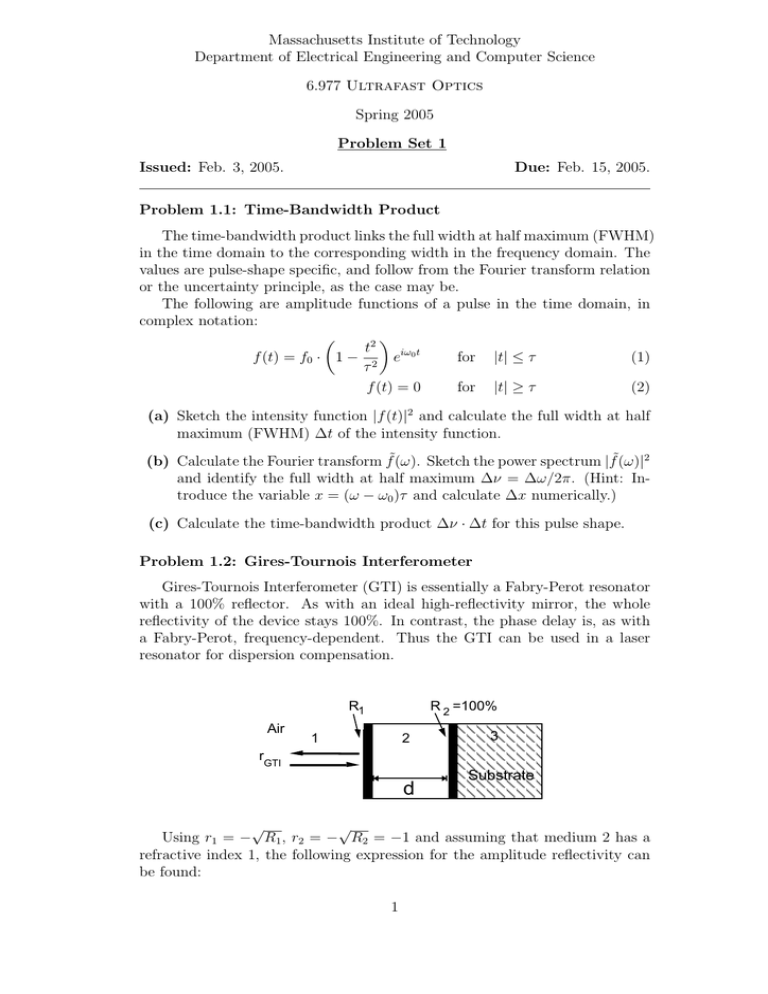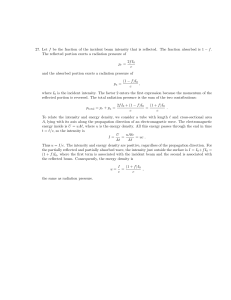Massachusetts Institute of Technology Department of Electrical Engineering and Computer Science
advertisement

Massachusetts Institute of Technology Department of Electrical Engineering and Computer Science 6.977 Ultrafast Optics Spring 2005 Problem Set 1 Issued: Feb. 3, 2005. Due: Feb. 15, 2005. Problem 1.1: Time-Bandwidth Product The time-bandwidth product links the full width at half maximum (FWHM) in the time domain to the corresponding width in the frequency domain. The values are pulse-shape specific, and follow from the Fourier transform relation or the uncertainty principle, as the case may be. The following are amplitude functions of a pulse in the time domain, in complex notation: � � t2 f (t) = f0 · 1 − 2 eiω0 t for |t| ≤ τ (1) τ f (t) = 0 for |t| ≥ τ (2) (a) Sketch the intensity function |f (t)|2 and calculate the full width at half maximum (FWHM) Δt of the intensity function. (b) Calculate the Fourier transform f˜(ω). Sketch the power spectrum |f˜(ω)|2 and identify the full width at half maximum Δν = Δω/2π. (Hint: In­ troduce the variable x = (ω − ω0 )τ and calculate Δx numerically.) (c) Calculate the time-bandwidth product Δν · Δt for this pulse shape. Problem 1.2: Gires-Tournois Interferometer Gires-Tournois Interferometer (GTI) is essentially a Fabry-Perot resonator with a 100% reflector. As with an ideal high-reflectivity mirror, the whole reflectivity of the device stays 100%. In contrast, the phase delay is, as with a Fabry-Perot, frequency-dependent. Thus the GTI can be used in a laser resonator for dispersion compensation. R1 Air R 2 =100% 1 1 2 3 rGTI Substrate d √ √ Using r1 = − R1 , r2 = − R2 = −1 and assuming that medium 2 has a refractive index 1, the following expression for the amplitude reflectivity can be found: 1 rGT I √ − R1 + e−i2βd √ = 1 − R1 e−i2βd (3) where β = 2π/λ and d is the thickness of Medium 2. (a) The relationship between intensity reflectivity R and amplitude reflec­ tivity r is R = |r|2 . Show that the intensity reflectivity RGT I is 100%, as long as there is no absorption or other loss in Medium 2. (b) Calculate the phase ΦGT I from rGT I and introduce ωt0 = 2βd (t0 is the round-trip time in Medium 2) in your final answer. GT I (c) Calculate the group delay Tg = − ∂Φ∂ω and the group delay dispersion ∂Tg Dg = ∂ω . From Problem (d) to Problem (h), suppose the thickness of Medium 2 is d = 150 µm and the reflectivity at the interface between medium 1 and 2 is R1 = 4 %. (d) Plot Tg and Dg as functions of wavelength λ in the band from 798 nm to 803 nm. (e) From the answer of (d), in which wavelength range can the GTI be used for dispersion compensation inside a laser resonator? Note that the laser crystals and air have positive group velocity dispersions. (f ) Suppose a 100-fs long Gaussian-shaped optical pulse (peak intensity is normalized to 1) centered at λ = 800 nm is reflected from the interface between medium 1 and 2 at t = 0. At t = 10 ps, how will the reflected pulse look like? Sketch the pulse at this point in time and specify as many numeric values as possible. (g) Now suppose a 10-ps long Gaussian-shaped optical pulse (peak intensity is normalized to 1) centered at λ = 800 nm is reflected from the interface between medium 1 and 2 at t = 0. At t = 20 ps, how will the reflected pulse look like? Sketch the pulse at this point in time and specify as many numeric values as possible. (h) The answers for Problems (f) and (g) will look quite different. Briefly explain the reason in the frequency and/or time domains. Problem 1.3: Kramers-Krönig Relations The linear dielectric susceptibility is the dielectric response of a medium to an applied electric field, i.e. it is the response of a causal linear time invariant system, and therefore real and imaginary parts obey Kramers-Krönig relations: 2 χr (Ω) = π �∞ ωχi (ω) dω = n2r (Ω) − 1 ω 2 − Ω2 0 2 (4) and 2 χi (Ω) = − π �∞ Ωχr (ω) dω, ω 2 − Ω2 (5) 0 where the complex susceptibility is χ(Ω) = χr (Ω) − jχi (Ω). (a) Using causality, prove the Kramers-Krönig relations. (Hint: A causal signal can be multiplied by a step function without changing.) (b) Suppose you know χi (Ω) for the whole frequency range. Then it might look easy to use Eqs. (4) and (5) to evaluate χr (Ω). But in fact, you will find the singularity in the denominator makes it difficult to numerically integrate those equations. How can you circumvent that problem and compute χr (Ω) from χi (Ω)? (Hint: Think about the symmetries of the real and imaginary parts of the complex susceptibility.) (c) How would you compute the refractive index of a medium, nr (Ω) = n0 + Δnr (Ω) (where Δnr � n0 ), if its absorption coefficient α(Ω) is known over the whole frequency range? Assume the absorption is weak, i.e. |χi | << 1 + χr and the background index n0 is known. 3






